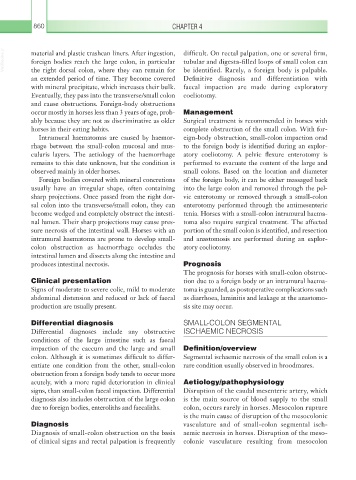Page 885 - Equine Clinical Medicine, Surgery and Reproduction, 2nd Edition
P. 885
860 CHAPTER 4
VetBooks.ir material and plastic trashcan liners. After ingestion, difficult. On rectal palpation, one or several firm,
tubular and digesta-filled loops of small colon can
foreign bodies reach the large colon, in particular
the right dorsal colon, where they can remain for
Definitive diagnosis and differentiation with
an extended period of time. They become covered be identified. Rarely, a foreign body is palpable.
with mineral precipitate, which increases their bulk. faecal impaction are made during exploratory
Eventually, they pass into the transverse/small colon coeliotomy.
and cause obstructions. Foreign-body obstructions
occur mostly in horses less than 3 years of age, prob- Management
ably because they are not as discriminative as older Surgical treatment is recommended in horses with
horses in their eating habits. complete obstruction of the small colon. With for-
Intramural haematomas are caused by haemor- eign-body obstruction, small-colon impaction orad
rhage between the small-colon mucosal and mus- to the foreign body is identified during an explor-
cularis layers. The aetiology of the haemorrhage atory coeliotomy. A pelvic flexure enterotomy is
remains to this date unknown, but the condition is performed to evacuate the content of the large and
observed mainly in older horses. small colons. Based on the location and diameter
Foreign bodies covered with mineral concretions of the foreign body, it can be either massaged back
usually have an irregular shape, often containing into the large colon and removed through the pel-
sharp projections. Once passed from the right dor- vic enterotomy or removed through a small-colon
sal colon into the transverse/small colon, they can enterotomy performed through the antimesenteric
become wedged and completely obstruct the intesti- tenia. Horses with a small-colon intramural haema-
nal lumen. Their sharp projections may cause pres- toma also require surgical treatment. The affected
sure necrosis of the intestinal wall. Horses with an portion of the small colon is identified, and resection
intramural haematoma are prone to develop small- and anastomosis are performed during an explor-
colon obstruction as haemorrhage occludes the atory coeliotomy.
intestinal lumen and dissects along the intestine and
produces intestinal necrosis. Prognosis
The prognosis for horses with small-colon obstruc-
Clinical presentation tion due to a foreign body or an intramural haema-
Signs of moderate to severe colic, mild to moderate toma is guarded, as postoperative complications such
abdominal distension and reduced or lack of faecal as diarrhoea, laminitis and leakage at the anastomo-
production are usually present. sis site may occur.
Differential diagnosis SMALL-COLON SEGMENTAL
Differential diagnoses include any obstructive ISCHAEMIC NECROSIS
conditions of the large intestine such as faecal
impaction of the caecum and the large and small Definition/overview
colon. Although it is sometimes difficult to differ- Segmental ischaemic necrosis of the small colon is a
entiate one condition from the other, small-colon rare condition usually observed in broodmares.
obstruction from a foreign body tends to occur more
acutely, with a more rapid deterioration in clinical Aetiology/pathophysiology
signs, than small-colon faecal impaction. Differential Disruption of the caudal mesenteric artery, which
diagnosis also includes obstruction of the large colon is the main source of blood supply to the small
due to foreign bodies, enteroliths and faecaliths. colon, occurs rarely in horses. Mesocolon rupture
is the main cause of disruption of the mesocolonic
Diagnosis vasculature and of small-colon segmental isch-
Diagnosis of small-colon obstruction on the basis aemic necrosis in horses. Disruption of the meso-
of clinical signs and rectal palpation is frequently colonic vasculature resulting from mesocolon

